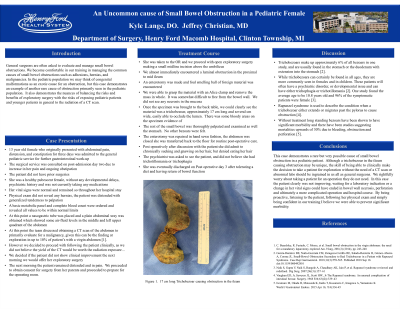General Surgery
An Uncommon cause of Small Bowel Obstruction in a Pediatric Female Patient

Has Audio
Introduction/Purpose: General surgeons are often asked to evaluate and manage small bowel obstructions. We become comfortable in our training in managing the common causes of small bowel obstructions such as adhesions, hernias, and malignancies. In the pediatric population we may think of congenital malformations as an exotic cause for an obstruction, but this case demonstrates an example of another rare cause of obstruction primarily seen in the pediatric population.
Methods or Case Description: A 13 year old female presented with abdominal pain, distension, constipation for three days. Abdominal xrays demonstrated dilated loops of small bowel with air fluid levels. She had no previous surgeries, was a healthy pubescent female with no developmental delays. She was made NPO and given IV fluids. The next morning her pain had increased, appeared more distended, and denied passing flatus or having a bowel movement. A follow-up xray showed increased small bowel distension. The decision was made to take the patient for exploratory laparotomy. On exploration a mass was palpated in the lumen of the mid ileum. An enterotomy was made, and a trichobezoar was removed.
Outcomes: She was discharged on post-operative day 3 after tolerating a diet. She denied a previous history of trichotillomania, although did admit to sucking on her hair. Trichobezoars make up approximately 6% of all bezoars in one study, and are usually found in the stomach or the duodenum with extension into the stomach.
Conclusion: This case demonstrates a rare but very possible cause of small bowel obstruction in a pediatric patient. Once again the importance of clinical examination and maintaining a high index of suspicion with a wide differential, in order to have a good outcome are evident in this case.
Methods or Case Description: A 13 year old female presented with abdominal pain, distension, constipation for three days. Abdominal xrays demonstrated dilated loops of small bowel with air fluid levels. She had no previous surgeries, was a healthy pubescent female with no developmental delays. She was made NPO and given IV fluids. The next morning her pain had increased, appeared more distended, and denied passing flatus or having a bowel movement. A follow-up xray showed increased small bowel distension. The decision was made to take the patient for exploratory laparotomy. On exploration a mass was palpated in the lumen of the mid ileum. An enterotomy was made, and a trichobezoar was removed.
Outcomes: She was discharged on post-operative day 3 after tolerating a diet. She denied a previous history of trichotillomania, although did admit to sucking on her hair. Trichobezoars make up approximately 6% of all bezoars in one study, and are usually found in the stomach or the duodenum with extension into the stomach.
Conclusion: This case demonstrates a rare but very possible cause of small bowel obstruction in a pediatric patient. Once again the importance of clinical examination and maintaining a high index of suspicion with a wide differential, in order to have a good outcome are evident in this case.
- KL
Kyle Lange, DO
Surgical Resident
Henry Ford Macomb
Henry Ford Macomb
Shelby Township, MI, US - JC
Jeffrey Christian, MD
Dayton Children's Hospital
Dayton, OH, US
